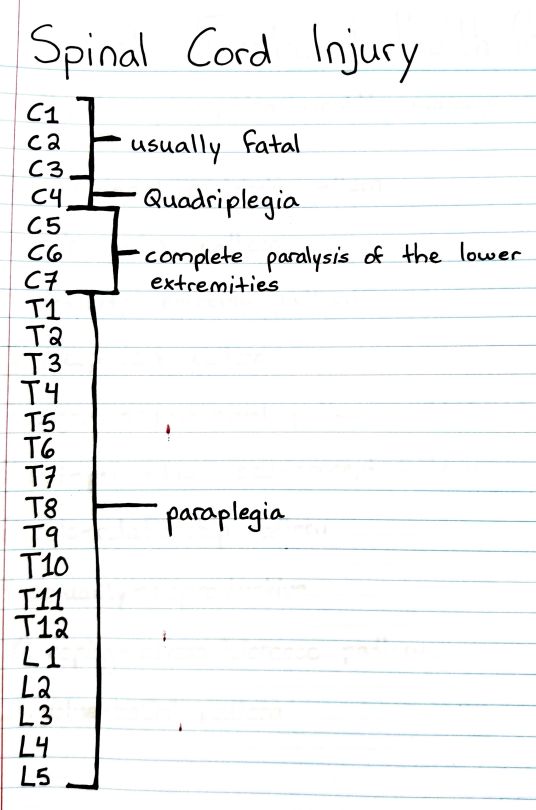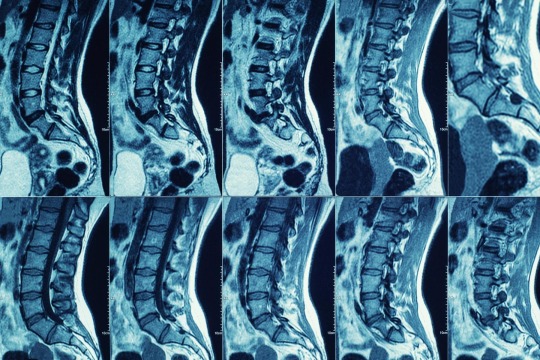#spinal cord injuries
Photo

#studyblr#notes#medblr#medical notes#med notes#emergency medicine#emergency medicine notes#ems#ems notes#emt#emt notes#emergency medical technician#emergency medical technician notes#spinal cord#spinal cord injuries#spine injuries#paraplegia#quadriplegia#paralysis#paralysis notes#paralysis levels#levels of paralysis
327 notes
·
View notes
Note
Okay I'm a whump fan and nursing student, and this seems like a dumb question but I cannot find information fucking anywhere. How do spinal fractures/nerve damage only paralyze the skeletal muscles and not cause organs to stop working? Is there a specific type of injury or point in the spine that's the dividing line between death and paraplegia? Also, is there anything that works in reverse? Either a smaller injury or medication to the spine or nerves. The area being numb or not and skeletal muscle control don't matter as long as the organs and nervous system communication required for life are stopped
The short answer is that it is very common to have some level of organ dysfunction after a spinal injury. Some vital organs just don't need the brain to tell them what to do to be effective, or rely on other signals, such as hormones or the vagus nerve to transmit those signals instead of the spinal nerves.

For example:
The heart needs signals from the vagus nerve, but that exits the skull at a different place than the spinal column, so it is usually unaffected in a spinal injury.
The kidneys and liver are mostly controlled via hormones.
The stomach gets some nerve supply from the vagus nerve, but some from the T6-T9 area of the spine. The stomach may be weakened if a spinal cord injury is higher than T6.
The rest of the gastrointestinal tract and bladder is affected by just about any spinal injury, though whether this is an inability to pass stool or stooling without meaning to depends on where the injury is.
Lungs/diaphragm are controlled at the level of C8 and above, causing difficulty or weakness in breathing.
Spinal cord injuries come in 2 main types: Complete and incomplete.
Complete spinal cord injuries mean generally that the spinal cord has been severed and most or all signals have been stopped. This is usually a loss of sensation, muscle control, and possibly a problem with smooth muscle tissue like that in veins and arteries (causing low blood pressure).
Incomplete means the spinal cord has been torn or otherwise injured but some nerves can still send signals to areas below the site of injury. Incomplete is more of a choose your own adventure writing-wise, since it might mean there is movement but no sensation, sensation but no movement, some organ dysfunction, or a combination.
Having a vertebra break doesn't necessarily mean the spinal cord will be injured, but it does mean it is more likely.
The following are common consequences of complete or near-complete spinal cord injuries:
C1-C4: "neck down" paralysis, difficulty breathing on own, difficulty urinating or defecating on own, difficulty speaking. trouble with maintaining blood pressure.
C5-C6: "Shoulder down" paralysis. Weak breathing but able to breathe and speak on own, difficulty urinating and defecating. Trouble with maintaining blood pressure. Can raise arms and bend elbows, difficulty moving hands and wrists.
C7-C8: "Armpit down" paralysis. Potentially weak breathing, able to use arms and hands, sometimes able to drive an adapted vehicle, may be able to transfer from bed to wheelchair, trouble maintaining blood pressure, bowel or bladder must be managed with catheter, medications, etc..
T1-T5: "Belly down" paralysis. Breathing is intact, but may not be able to hold themselves up due to weakness of back and abdominal muscles. Trouble maintaining blood pressure. Bowel or bladder must be managed with catheter, medications, etc..
T6-T12: "Pelvis down" paralysis. Can probably hold themselves up in a wheelchair, may walk with braces or walking frame, bowel or bladder must be managed with catheter, medications, etc..
L1-L5: "Buttock down" paralysis. May have difficulties with bowel and bladder that can be managed with incontinence supplies, may be able to walk with braces or walking frame, may have some specific movements in legs.
S1-S4: "Buttock down" weakness. Difficulties with controlling bowel and bladder that can be managed with incontinence supplies, probably able to walk with braces. Depending on level of injury may have some leg movements but not others.
53 notes
·
View notes
Text

20 notes
·
View notes
Text
youtube
#How Light Influences The Brain | Dr. Kyle Daigle | KAJ Masterclass LIVE How Light Influences the Brain with Dr. Kyle Daigle
Dr. Kyle Daig#spinal cord injuries#children with developmental delays#professional athletes#chronic illnesses and business executives. Dr. Daigle uses multiple approaches to helping patients recover from diet#nutritional supplementation#redlight therapy#cranial nerve stimulation#video games#music therapy#and physical exercises.
Want to create live streams like this? Check out StreamYard: https://streamyard.com/pal/d/4859318626680832#Youtube
0 notes
Link
Abramorama announced they have acquired the North American theatrical rights for the inspiring feature-length documentary Full Circle, an unblinking examination of the challenges of Spinal Cord Injury, and a celebration of the growth that such tragedy can catalyze.
#janet walker#haute-lifestyle.com#the-entertainment-zone.com#abramorama#snowboarder#sports injury#spinal cord injuries
1 note
·
View note
Text

how ablebodied people look at me after telling me they’d violently kill themselves if they had my disability
2K notes
·
View notes
Text
happy disability pride to all of my fucked up spine havers
happy disability pride to those of us who have spinal cord injuries, degenerative disc disease, ankylosing spondylitis, scoliosis, kyphosis, lordosis, spinal arthritis, cauda equina syndrome, tethered cord syndrome, spinal fusions, stenosis, myelopathy, radiculopathy, spondylolithesis, craniocervical instability, spina bifida, spinal tumors, syringomyelia, and anything else spine related
we are so very cool and i love you all so much
#disability pride month#disabled pride#disability pride#disabled pride month#cripplepunk#cripple punk#cpunk#actually disabled#physically disabled#disabled#disability#physical disability#spinal cord injury#SCI#degenerative disc disease#ankylosing spondylitis#scoliosis#kyphosis#lordosis#cauda equina syndrome#spinal fusion#stenosis#myelopathy#radiculopathy#spondylolisthesis#CCI#spina bifida#spinal tumor#syringomyelia
5K notes
·
View notes
Link
Spinal cord injuries can affect you overall well-being and your quality of life. Find out how it can impact you and how you can cope with it.
0 notes
Text
Finding meaning and joy after spinal cord injury
Finding meaning and joy after spinal cord injury
August 26, 2022 – Preethi Srinivasan was an 18-year-old with a bright future in sports and academics. She was a state level medalist in swimming, was also a skilled cricketer and dreamed of representing her native India in cricket.
Her academic performance was equally amazing and she took a 5 year MBA course in Chennai, India. “My life was perfect and the possibilities seemed endless,” she says…

View On WordPress
0 notes
Text
Shoutout to paralyzed people. Those with complete paralysis, incomplete paralysis; Those whose paralysis was caused from accidents, brain injuries, strokes, spinal cord injuries, neurological illnesses; Those with paraplegia, quadriplegia, hemiplegia, tetraplegia. Who were born paralyzed or became paralyzed later in life.
Those who have a carer, those who use a wheelchair full-time, those who use crutches or canes and those whose mobility aid is a hospital bed. Those with incontinence, who wear adult diapers, ostomy bags and catheters. You are not "lesser" for needing care or not being able to live independently. You deserve to live a comfortable life with autonomy and dignity.
We rock. We're fucking amazing. I love you.
#disabled positivity#cripplepunk#cpunk#paralysis#paralyzed#hemiplegia#paraplegia#quadriplegia#tetraplegia#actually disabled#physically disabled#neurological disability#spinal cord injury
1K notes
·
View notes
Text
me looking at supposed cripplepunk members treat cancer patients and ppl like spinal cord injuries like shit again.
yall do better. you can't be cripplepunk but only include low support needs ppl. people are dying. disabled people are dying. and yall don't care.
#cancer#cancer patient#spinal cord injury#paralysis#cripplepunk#cripple punk#cpunk#disability#actually disabled#affo ramble#affo rant#chronic illness#terminally ill#physical disability#DONT DERAIL THIS POST IS ABT CRIPPLES
885 notes
·
View notes
Text
disabled regina george is a concept

#disabled regina george#regina george#mean girls 2024#renee rapp#what if regina george has spinal cord injury from being hit by a bus#she has chronic back and leg pain#and POTS
161 notes
·
View notes
Text

11 notes
·
View notes
Text
"It’s long been supposed that implants could connect prosthetics to the brain in a way that stimulates nervous system commands with electrical signals.
Now, this idea is closer than ever to realization in a meaningful way, as one man paralyzed from the hips down is able to walk unsupported, even up stairs, thanks to such electrical nerve stimulation.
The patient, Gert-Jan Oskam, lost all movement in his legs after suffering a spinal cord injury in a motorbike accident. After using a precursor technology to gain back a little bit of mobility, Oskam enrolled in a proof of concept study to perhaps make further advances...
Now, with an implant in his brain, when Oskam thinks about moving his legs, it sends a signal to a computer he wears in a backpack that calculates how much current to send to a new pacemaker in his abdomen. It in turn sends a signal to the older implant in his spinal cord that prompts his legs to move in a more controllable manner. A helmet with antennae helps coordinate the signals.
The scientists developing the technology and working with him detail that he can walk around 200 meters a day, and stand unassisted for around 2-3 minutes. Once, Oskam details, there was some painting that needed to be done, but no one was around to help him. With the new technology, he simply took his crutch and did it himself.
youtube
Incredibly, after less than a year, and completely unexpectedly, scientists believe the technology closed the gap in his nervous system, and he can now lift himself out of a chair, and even walk with the help of a crutch, even when the device is turned off.
The scientists are planning in the future to work with patients with paralyzed arms and hands, and even with stroke victims, as the “digital bridge” is a massive advancement in nervous system stimulation technology."
-via Good News Network, June 16, 2023. Video via NBC News, May 24, 2023
#medical news#medical research#paralysis#neuroscience#nervous system#neurology#neuroplasticity#neuroplasticity is presumably the reason the “gap” in his nervous system closed?#and neuroplasticity is fucking amazing#the implications of this for medical science are potential HUGE#transhumanism#spinal cord injury#spinal cord stimulator#good news#hope#Youtube#cyberpunk
633 notes
·
View notes
Text
In a new study in mice, a team of researchers from UCLA, the Swiss Federal Institute of Technology, and Harvard University have uncovered a crucial component for restoring functional activity after spinal cord injury. The neuroscientists have shown that re-growing specific neurons back to their natural target regions led to recovery, while random regrowth was not effective.
Continue Reading.
208 notes
·
View notes